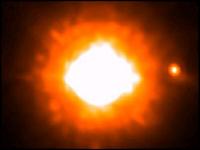







|
News and Information
Telescopes see 'distant planet'
| April 4, 2005 |

GQ Lup, European Southern Observatory
The new "planet" (right) orbits a relatively young star
A European team claims to have obtained the first direct image of a planet beyond our own Solar System.
The "extrasolar planet" is said to orbit a star called GQ Lup - thought to be like a young version of our Sun.
Similar claims have been made in the past, but sceptical scientists believe the pictures merely show objects that share the same view in the sky.
The GQ Lup object is far more certain claims Ralph Neuhaeuser's team in the journal Astronomy & Astrophysics.
GQ Lup and its companion are located in a star-forming region about 400 light-years away.
The "planet" has been observed by the team since 1999.
The astronomers have used image data from the European Southern Observatory's (ESO) Very Large Telescope (VLT) in Chile, the Hubble Space Telescope and the Japanese Subaru Telescope in Hawaii.
Because it is in a young system, the planet is said to be relatively hot. This helped the team detect the planet in the glare from its host star, the group says.
The planet is also quite far from GQ Lup - about 100 times the distance between the Sun and the Earth, which assisted the team in separating the light from the two objects.
The team models the mass of the companion to be 1-2 times that of our own Jupiter.
Astronomers have found about 130 exoplanets over the past decade, but most of these have been detected via the gravitational "wobbles" they induce in their parent stars.
The limitations of current technology make it very difficult to see a planet directly.
It is expected that such images will not become routinely available until new space-borne planet-hunting telescopes are launched in the next decade.
Some scientists have already questioned whether the GQ Lup companion is an exoplanet. They have concerns over the size of the object, which by the team's own admission could be as high as 42 Jupiter masses.
If confirmed at the top end of this scale, it would make the object a brown dwarf (a failed star), not a planet. |
Source: www.bbc.com |
| http://news.bbc.co.uk/2/hi/science/nature/4408187.stm |
|
| Support Caprivi Freedom |
Fill out the form below to become a member of this site and receive our regular newsletter.
|

|

